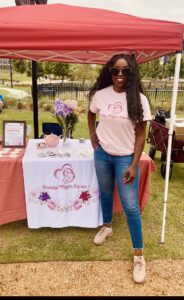Kelly Schexnaildre is the founder and CEO of Merfs Condiments, which manufactures, sells, and distributes a diversified portfolio of high-quality, shelf-stable spicy foods across the United States and Canada. Kelly has fifteen years of restaurant experience and possesses an ongoing awareness of new culinary trends. She is passionate about mealtime as an opportunity to build community and creates products that will bring joy to every dish. Kelly moonlights as a writer, speaker, and guest personality on podcasts and blogs such as Endless Hustle and Best Served. Kelly can be found in South Florida spending time fishing, writing, reading, talking about God, lifting weights, and playing softball. She drinks a lot of coffee, is a Scrabble master, does crossword puzzles and Sudoku, and loves to take walks.
Were you into cooking at an early age or where did that originally start?
I made my first full meal at age seven. Both my parents are avid cooks, and my dad is known for his barbecue. My dad’s grandmother owned a commercial catering business, and his mother was also a wonderful cook. My mom, born and raised in Kentucky, is a little less passionate about cooking, but she’s still very good at it. I was born and raised in South Louisiana, a cultural Mecca for food with the confluence of African, Spanish, and French cuisines. We blend spicy peppers with the richness of cream and butter and pair it with the local catch of seafood: crawfish, oysters, shrimp, redfish, and trout. Growing up, I ate seafood multiple times a week, and we always ate at home. My parents let me help in the kitchen, and I discovered my first true love: cooking. From then on, I made family dinner often.
Did you have a pallet for spicy foods or can handle your spices?
I’ve been eating spicy foods since I was little, just like my dad and anyone else that grew up in South Louisiana. Our fondness for chili peppers comes from our Spanish colonization; they brought and planted chili pepper seeds that were non-native to the area. I remember multiple times where my mom made dishes that were too spicy for us to eat, and we’d all be sweating at the dinner table.
Were spicy sauces the main goal with the launch of Merfs Condiments?
I really didn’t have any idea for the business until 2012. I just didn’t want to go to graduate school and I didn’t want to wait tables for the rest of my life, so I started Merfs Condiments. I spent quite a lot of time working in the restaurant business as a server, bartender, line cook, host, expeditor, and dishwasher. I mean, you name it, and I’ve done it in a restaurant. At the time, I was recreationally making a lot of condiments from the extra produce in my garden: everything from relish to tomato sauce. I started making hot sauce, and honestly, the hot sauce just took off. People were stealing it out of my fridge and asking for bottles as Christmas gifts. I really discovered by accident that I had a real gift for making hot sauce. Even though I was the resident sauce expert in my childhood home, I never really carried that into a love for hot sauce. When I started the business in 2014, there were only a couple of brand-new craft hot sauce companies in Colorado, which made the market for a new hot sauce company easy to break into. Now there’s probably more than 50 hot sauce companies in Colorado alone. The market was available for it and it was something I was good at, so I just decided to do it.
Were there any mistakes that national hot sauce brands were making that you wanted to change?
What I see in certain hot sauces brands is the fact that they’re all red, thin, and vinegary. I was thoroughly unimpressed and really thought that hot sauce could be a condiment that could be so much more for the consumer than just a thin red vinegar style chili sauce. Can we incorporate some fruits or fresh chilies? Can we incorporate a variety of chilies outside of cayenne and Arbol? I really wanted to just make hot sauce that was a variety of textures and flavors and heat levels that could appeal to anyone and be used on any food.
Were there any additional changes in the flavor profile behind your sauces?
The big change has been swapping sugar for monkfruit sweetener. The flavor idea behind my brand is sweet, sour, umami, and salt. So, I really wanted to try to incorporate all those elements into each of the hot sauces. Originally, I was using sugar in a couple of my products, but once I made the switch to a Primal lifestyle and learned about sugar’s harmful impact on the body, I felt I could no longer serve it to my customers. I switched to monkfruit sweetener, which is a sugar replacement that is all natural. It has a low glycemic impact in the body, meaning that it doesn’t raise blood sugar and prompt an insulin response in the bloodstream. Less insulin equals less cortisol and less inflammation.
Can you expand on this primal health concept and what it has done in your life?
I am a certified Primal Health Coach. I got my certification through the Primal Health Institute, which is an offshoot of Mark Sisson’s Primal Blueprint program. Mark Sisson is a guy in his late sixties that was a competitive athlete for a long time. He realized after a point that the standard American diet high in carbs and sugar, was destroying his body. He promptly switched to Paleo, and he felt better than he ever had before. All his health markers improved, and his joints stopped hurting. Paleo is only eating meats, vegetables, healthy fats, and some fruits. Primal takes that a step further and promotes eating less than 100g of carbs a day. The idea is that if you eat a low-carb diet, you can healthily maintain your weight for the rest of your life without issue, and you’ll dramatically reduce the systemic inflammation that is endemic with the Standard American Diet. Over the last three years, I’ve found that to be completely true. My asthma and allergies improved dramatically when I switched to Primal and my joints have stopped hurting. I lost 25 pounds in the first six months, and I’m in the literal best shape of my life. I’ll never go back to eating the Standard American high carb high sugar diet. It’s what’s keep us fat and sick. I really believe that our food companies are in bed with the medical industry, and they’re poisoning the American people because it benefits them. I don’t want to be a part of that.
Did you have to start sourcing out parts of the business as you were expanding?
Merfs had always manufactured its own products in house until summer 2020. As a result of COVID19, all my revenue disappeared overnight for a stretch of about 300 days. Had I not gotten the economic injury disaster loan from the SBA, Merfs would no longer exist, and through no fault of my own. I made the decision to close the manufacturing facility and switch to co-packing in order to reduce my overhead expenses. I sold all my equipment and let go of my employees. To be clear, co-packing has had no impact on the quality of the products; they’ve all been recipe tested and approved by me.
Have you liked that transition of allowing certain tasks to be handled by other departments?
Initially it was a little hard to transition. I had spent the life of the business controlling all the manufacturing and working with all my vendors, suppliers, producers, and managing employees.
It was also incredible to be able to tightly control my costs. It took about 10 months for me to get comfortable with the switch and to get all the systems in place that allow it to run smoothly. The alternative now, is that instead of working 55-60 hours a week, owning a manufacturing facility, and constantly maintaining equipment and all this other stuff, I now work about 25 or 30 hours a week. And I’m a hell of a lot more productive because I can focus solely on sales and the things that bring money and new clients to the business instead of focusing on the day-to-day operations.
I’ve reduced my workload, outsourced manufacturing and fulfillment, and made myself more productive. All of this enabled me to consider working remotely. Before, I was completely married to Denver, I was going to have to live there until I died or gave up the manufacturing facility. And when stuff hit the fan last year, I started thinking about, “What do I want out of my life? I don’t want to live in a place where a thousand square foot house costs half a million dollars, and it’s cold for eight months out of the year. I want live somewhere that’s got a little bit more freedom and flexibility and nicer weather. And so, I made a move to South Florida. I’ve always wanted to live here, and I still love Colorado. Maybe one day I’ll be rich enough to live between the two but for now, South Florida is quite lovely.
Are there any upcoming projects for 2022 in your business?
In 2022, I’m going to focus on diversifying our revenue streams, both national, international, and online. The way of the future is online sales. Merfs has a lot of listings on Amazon Prime now, and Prime members can buy Merfs with free two-day shipping. I’m working on a Canadian expansion project right now, and we’re eager for any new opportunities that might come our way!

